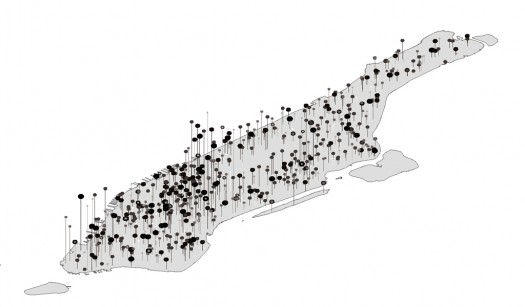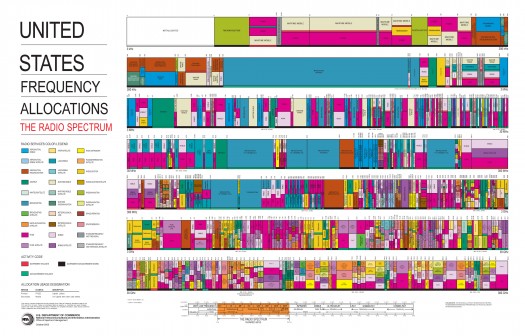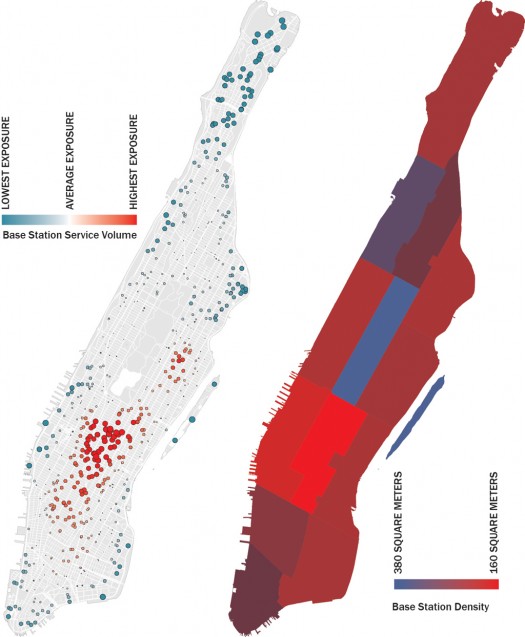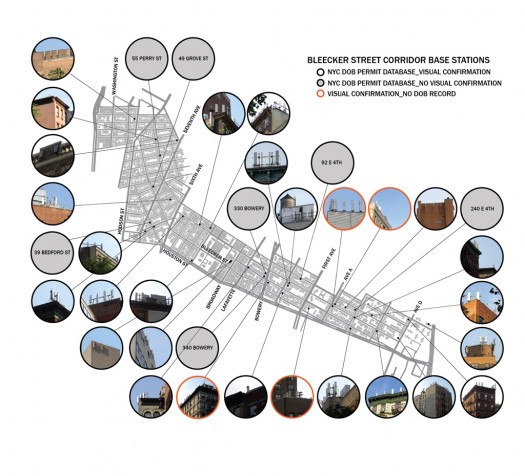
We are celebrating 15 years — and counting — of stories that are deeply researched and deeply felt, that build a historical record of what the city has been.
We are celebrating 15 years — and counting — of stories that are deeply researched and deeply felt, that build a historical record of what the city has been.
Mobile communication networks, seemingly the most invisible of infrastructures, have an enormous potential impact on the physical environment of the city. As wireless usage skyrockets, the capacity of the network is pushed to its limits, and the technologies that control and transmit the signals must adapt to meet the demand. Today’s rooftop base stations and inconspicuous antennae (some of which are more noticeable than others) will become — in whatever shape they take — ubiquitous features of our urban space. To begin to comprehend the ways that this infrastructural layer has already spread across the city and how designers can involve themselves in its future form, Michael Chen, a principal of Normal Projects and adjunct assistant professor at the Pratt Institute School of Architecture, and Justin Snider, a designer and researcher, embarked on a research project they call Signal Space. The project is part of an ongoing inquiry into broadcast and antenna infrastructure by Chen and Snider, which involves sensing, simulation and visualization methods, a public data-gathering event series and an upcoming piece in BRACKET [goes soft]. Here, Chen shares some of his research so far: an investigation into the physical, spatial, technological, public, private, governmental and design significance of this new stratum of urban space — signal space. –V.S.

The locations, heights and age of the mobile phone antenna installations filed with the Department of Buildings since 2005. The variable density of base stations is a reflection of the extremes of architectural topography and the obstruction environment, as well as the volume of user demand.
The relationship between mobile infrastructure and a city like New York is complex, and subject to many different forms of negotiation. It is also subject to a remarkable degree of change, reflecting the evolving form of the city itself and the novel ways that people engage it. The variables that concern how mobile infrastructure operates, how it is deployed and located within the city, and how its tactics change over time are certainly all spatial in nature. And taken as a whole, the negotiation between the infrastructure and the city describes a fundamentally new form of space – the signal space of the city – where the city and its electromagnetic transmission environment meet.
Mobile networks are at once invisible, and are also the systems most associated with the soft dimensions of infrastructure and its potential to act as an engine for large-scale social, economic and technological change. At a recent conference on mobile communications technology, the chairman of the Federal Communications Commission noted that “no sector of the communications industry holds greater potential to enhance America’s economic competitiveness, spur job creation and improve the quality of our lives.” And just as the operational and physical dimensions of conventional infrastructure, from transportation to utilities, manifest themselves and influence the growth of the city in important ways, signal space can be understood as a new and important public space, located at a nexus of public, corporate, governmental and technological concerns.
While much of the speculation about the future of the city in relation to mobile networks has been focused on applications and potential uses of the technology, less attention has been devoted to the way that the technology itself is developing and the impact that it may have on the city. Our research into mobile infrastructure centers around identifying some of the developments in mobile technology that have the greatest potential to affect the future development of the city, and speculating on where they may have particular relevance for design. Our aim has been to theorize and document signal space, to increase its visibility, and to make its protocols and characteristics available for action.
SECTORIZING THE CITY
At the most fundamental level, a mobile phone is a two-way radio. The phone contains an antenna that communicates with a mobile base station nearby. A base station generally includes a series or array of antennas that receive and transmit signals, and a computer that coordinates the communication and interfaces with the cabled phone system. The structure of mobile networks is generally comprised of sectors or cells, defined as the overlapping region of three base stations. At its simplest, a cellular network can be imagined as a continuously tiled set of hexagonal cells, with base stations located at every other vertex. An individual user making or receiving a call communicates with a nearby base station. As that user moves out of range, the signal is shared between other base stations within range until the most optimum base station is identified and the call is handed over.
The broadcast spectrum is a finite resource, so the region of the broadcast spectrum available for any given technology is rigorously policed and legislated. Mobile networks have access to a limited range of frequencies, so cellular communication is based on the reuse of frequency channels within the network. Any of the frequencies associated with a given cell are being reused at another cell, usually nearby but far enough away to avoid co-channel interference.

Frequency Allocations of the Radio Spectrum from the Federal Communications Commission (FCC) | Right-click and open in a new window to see details.
The capacity of the system is limited by interference from the environment and by the depletion of available channels due to an increasing number of users. Each base station can only accommodate a certain number of simultaneous users, for instance, so one of the primary methods for increasing the capacity of mobile network technologies relies on subdivision — sectorizing the city into smaller and smaller individual frequency zones.
The surest measure of signal quality is the unobstructed line of sight from antenna to receiver. In dense environments, like cities, signals tend to be reflected off of obstructions and arrive out of phase at the receiving antenna. Coverage is dependent not only on the availability of a signal at a given location, but on the network’s ability to maintain a signal over time, throughout an individual cell, and as a user moves from cell to cell. Mobile base stations are strategically located to optimize the “fit” between the available signal and the specific physical environment. The complexity of this relationship is such that most base stations are located as a result of experimental testing and local calibration because no sufficiently powerful analytical methods or modeling are available to determine the behavior of signals.

Base stations and antennae | L-R: Jane Street at Hudson; E. 4th St. between Ave. A and Ave. B; E. 2nd St. and Ave D; Sullivan and W. 3rd St.
The FCC, in recent years, has authorized a three-fold increase in the commercial spectrum, which includes the recent auction of 700MHz frequencies previously in use by analog television. However, given that a 35-fold increase in wireless traffic is expected over the next five years, mobile providers constantly add antennas to their networks. While a single base station might have a range measured in miles in an unobstructed environment, in an urban setting installations are often separated by only a few hundred feet.
Rapidly increasing demand will mean that base stations, which today are almost exclusively located semi-stealthily on mid-rise building rooftops, will not only become denser, but will likely migrate into interiors, streets and other public spaces. The radical densification of sectoring into ever-smaller cells affords finer degrees of control over the transmission. It also calls for a miniaturization of the antenna equipment to allow for easier integration with other structures and camouflage. Already, hundreds of thousands of femtocells (small-scale base stations for boosting wireless signals indoors that are the size of a Wi-Fi router) are currently installed throughout the United States.

Base Station Density | L: The service volume, or exposure, for each base station was determined by calculating the total interior square footage of buildings within the broadcast radius of each antenna point. The size and color of each base station is proportional to its positive or negative deviation from the mean exposure. Not surprisingly, in Midtown Manhattan a high number of base stations service a large amount of building volume, or user volume. Fairly large differences are evident, though between the Upper West and Upper East Sides. | R: Base Station density by New York City Community District. The average density of antennas in Manhattan is one for every 218 square meters. Evaluated by community district, the density ranges from 380 square meters at the low end to 160 square meters on the high end. A number of other administrative boundaries show wide variation in the density of base stations. For instance, Landmark Districts as a whole have considerably fewer installations and on average have an antenna density just over half of that of the rest of Manhattan.
PROLIFERATION OF THE MOBILE NETWORK
One of the most significant factors in the development of the infrastructure and its proliferation will be any proposed change to the registration and reporting requirements currently in existence. No comprehensive documentation on the mobile infrastructure in New York is available, largely because the infrastructure itself is entirely owned by corporate entities and installations on specific buildings are often negotiated in private. Since 1998, New York City’s building code requires that new rooftop installations be approved under an alteration permit, though no data concerning the operation of a base station or its conformance to FCC radiation regulations are maintained by the City. And since 2005, the Department of Buildings has maintained a cellular antenna information database with information on mobile antenna permits. This data, coupled with registration from the FCC and FAA (above 200 feet, antennas must be registered as potential flight hazards), constitutes a substantial record of the infrastructure. To start to get a picture of the built infrastructure of mobile networks in New York, we developed a series of maps (seen throughout this piece) by cross-referencing permit and registration data with the NYC Planning Department’s PLUTO and LION datasets, as well as individual building information from the New York City Data Mine.
Not only are base stations proliferating, they are also developing sophisticated spatial senses and intelligence. Base stations employ spatial algorithms, probabilistic modeling and other soft computing methods to anticipate and coordinate the effects of signals that are lost, delayed, or arriving out of phase with the primary transmission. In effect, they reconstruct signals from the interference generated by the physical environment and are able to anticipate the transmissibility of a signal given a specific environment and user.
SIMULACRUM OF THE CITY
“Smart” antenna installations are designed to customize a radiation pattern for each individual user as a means to better negotiate obstruction-rich environments and to greatly increase the capacity of a given base station’s limited set of frequencies. The sensitivities of each component of the network are precisely tuned to users and to the physical environment alike. In aggregate, they add up to what is unquestionably one of the most comprehensive representations of the city in existence, capable of accounting for the physical obstruction environment of the city (its physical form) and the activities, communications, data transmissions and locations of the network’s users. As the network becomes denser, and cells finer, the resolution of the signal spaces increases dramatically.

Visually confirming the data set along the Bleecker Street and East 3rd Street from the Hudson River to the East River. While base stations are most frequently absorbed into the visual noise of rooftops, a number of camouflaging techniques related to color and matching brick textures are apparent. This limited sampling also reveals the broad range of scales associated with equipment. It is common in the far East Village, for instance, to see installations covering entire rooftops.
As recent reports have widely publicized, mobile phones and base station computers store significant personal data. That information, coupled with the emerging spatial and user sensitivities of the infrastructure itself, could be understood as a unique form of spatial memory. Proposals to embed sensors into mobile phones for sniffing out bioterrorism agents or nuclear radiation are indications of the network’s potential to support crowd-sourced passive surveillance, but also to retain memory of the activities of the city at particular locations and in relation to particular spatial environments.
In his work Simulacra and Simulation, Jean Baudrillard recounts a fable by Jorge Luis Borges where a great empire creates a map of its territory so exact that it approaches the size of the territory itself. In many ways, the memory built into signal space reflects Baudrillard’s observation that in contemporary societies, the simulacrum supersedes the actual territory itself. In 2003, New York City’s Department of Information, Technology and Telecommunications collected information about signal quality by inviting New Yorkers to report areas with poor cell phone reception, so that they could be reported to mobile carriers. More recently, in a 2011 paper, researchers at AT&T Labs have proposed that cell phone user data has the potential to dramatically change the future of urban planning, noting that “cellular networks must know the approximate locations of all active cellular phones in order to provide them with communication services. Given the ubiquity of these phones and their almost constant proximity to their owners, cellular networks can be used to opportunistically sense the locations of large populations of people. They thus provide a means to monitor city dynamics frequently, cheaply and at an unprecedented scale.”
.All images, except the FCC Frequency Allocations graphic, by Michael Chen and Justin Snider.
The views expressed here are those of the authors only and do not reflect the position of The Architectural League of New York.